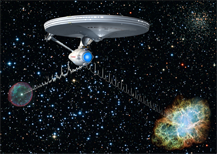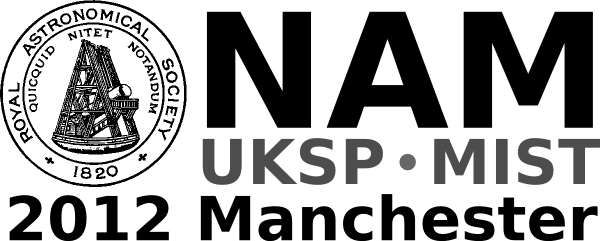UK-Germany National Astronomy Meeting NAM2012
How interstellar beacons could help future astronauts find their way across the universe
Royal Astronomical Society press release
RAS PR 12/24 (NAM 15)
Friday 30 March 2012

Artist's impression of pulsar-based navigation in deep space. The characteristic time signatures of strongly magnetised and fast spinning neutron stars, called pulsars, are used as natural navigation beacons to determine the position and velocity of a spacecraft.
The use of stars, planets and stellar constellations for navigation was of fundamental importance for mankind for thousands of years. Now a group of scientists at the Max-Planck Institute for Extraterrestrial Physics in Garching, Germany have developed a new technique using a special population of stars to navigate not on Earth, but in voyages across the universe. Team member Prof. Werner Becker will present their work at the National Astronomy Meeting in Manchester on Friday 30 March.
Have you ever asked yourself how the starship Enterprise in the TV series Star Trek found its way through the depths of space? Cosmic lighthouses called pulsars might be the key to this interstellar navigation - not only in science fiction but also in the near future of space flight.
When stars much more massive than our Sun reach the end of their lives, their final demise is marked by a dramatic supernova explosion that destroys most of the star. But many leave behind compact, incredibly dense remnants known as neutron stars. Those detected have strong magnetic fields that focus emission into two highly directional beams. The neutron star rotates rapidly and if the beam points in the direction of the Earth we see a pulse of radiation at extremely regular intervals - hence the name pulsar.
Prof. Becker and his team are developing a novel navigation technology for spacecraft based on the regular emission of X-ray light from pulsars. Their periodic signals have timing stabilities comparable to atomic clocks and provide characteristic time signatures that can be used as natural navigation beacons, similar to the use of GPS satellites for navigation on Earth.
By comparing the arrival times of the pulses measured on board the navigator spacecraft with those predicted at a reference location, the spacecraft position can be determined with an accuracy of few kilometres, everywhere in the solar system and far beyond.
At the moment even the fastest spacecraft would take thousands of years to travel to the nearest star and far longer to explore the wider Galaxy so we are unlikely to see journeys like this happen for many centuries. Nonetheless, the pulsar-based navigation system could be in use in the near future.
Professor Becker gives two examples: "These X-ray beacons could augment the existing GPS/Galileo satellite navigation systems and provide autonomous navigation for interplanetary space probes and future manned missions to Mars."
He adds: "Looking forward, it's incredibly exciting to think that we have now the technology to chart our route to other stars and may even be able to help our descendants take their first steps into interstellar space."
IMAGE AND CAPTION
Web: http://www.xray.mpe.mpg.de/~web/psrnav
Artist's impression of pulsar-based navigation in deep space. The characteristic time signatures of strongly magnetised and fast spinning neutron stars, called pulsars, are used as natural navigation beacons to determine the position and velocity of a spacecraft.
Pictures of spaceships: Rosetta (courtesy of ESA), Star Trek spaceship Enterprise.
MEDIA CONTACTS
NAM 2012 Press Office (0900 - 1730 BST, 27-29 March; 0900 - 1630 BST 30 March)
Room 3.214
University Place building
University of Manchester
Manchester
UK
Tel: +44 (0)161 306 7313
Dr Robert Massey
Royal Astronomical Society
Mob: +44 (0)794 124 8035
Email: rm@ras.org.uk
Anita Heward
Royal Astronomical Society
Mob: +44 (0)7756 034 243
Email: anitaheward@btinternet.com
Dr Klaus Jaeger
Pressereferent / Press Officer im Vorstand der Astronomischen Gesellschaft
Tel: +49 6221 528 379
Email: pressereferent@astronomische-gesellschaft.de
Dan Cochlin
Media Officer (Faculty of Engineering and Physical Sciences)
University of Manchester
Tel: +44 (0)161 275 8387
Email: daniel.cochlin@manchester.ac.uk
SCIENCE CONTACTS
Prof. Werner Becker
Max-Planck Institut für extraterrestrische Physik
Giessenbachstrasse
85741 Garching
Germany
Tel: +49 89 30000 3588
Mob: +49 175 2909293
Email: wbecker@mpe.mpg.de
Prof. M. G. Bernhardt
Max-Planck Institut für extraterrestrische Physik
Giessenbachstrasse
85741 Garching
Germany
Tel: +49 89 30000 3502
Mob: +49 176 51350026
Email: mbernhardt@mpe.mpg.de
NOTES FOR EDITORS
NAM 2012
Bringing together more than 900 astronomers and space scientists, the National Astronomy Meeting (NAM 2012) will take place from 27-30 March 2012 in the University Place conference centre at the University of Manchester in the UK. The conference is a joint meeting of the Royal Astronomical Society (RAS) and the German Astronomische Gesellschaft (AG) and is held in conjunction with the UK Solar Physics (UKSP: www.uksolphys.org) and Magnetosphere Ionosphere Solar Terrestrial (MIST: www.mist.ac.uk) meetings. NAM 2012 is principally sponsored by the RAS, AG, STFC and the University of Manchester.
The Royal Astronomical Society
The Royal Astronomical Society (RAS: www.ras.org.uk), founded in 1820, encourages and promotes the study of astronomy, solar-system science, geophysics and closely related branches of science. The RAS organises scientific meetings, publishes international research and review journals, recognizes outstanding achievements by the award of medals and prizes, maintains an extensive library, supports education through grants and outreach activities and represents UK astronomy nationally and internationally. Its more than 3500 members (Fellows), a third based overseas, include scientific researchers in universities, observatories and laboratories as well as historians of astronomy and others.
The Astronomische Gesellschaft (AG)
The Astronomische Gesellschaft (AG: www.astronomische-gesellschaft.de), founded in 1863, is a modern astronomical society with more than 800 members dedicated to the advancement of astronomy and astrophysics and the networking between astronomers. It represents German astronomers, organises scientific meetings, publishes journals, offers grants, recognises outstanding work through awards and places a high priority on the support of talented young scientists, public outreach and astronomy education in schools.
The Science and Technology Facilities Council
The Science and Technology Facilities Council (STFC: www.stfc.ac.uk) is keeping the UK at the forefront of international science and tackling some of the most significant challenges facing society such as meeting our future energy needs, monitoring and understanding climate change, and global security. The Council has a broad science portfolio and works with the academic and industrial communities to share its expertise in materials science, space and ground-based astronomy technologies, laser science, microelectronics, wafer scale manufacturing, particle and nuclear physics, alternative energy production, radio communications and radar. It enables UK researchers to access leading international science facilities for example in the area of astronomy, the European Southern Observatory.
Jodrell Bank Centre for Astrophysics
The Jodrell Bank Centre for Astrophysics (JBCA: www.jb.man.ac.uk) is part of the School of Physics & Astronomy at the University of Manchester. JBCA is split over two main sites: the Alan Turing Building in Manchester and the Jodrell Bank Observatory in Cheshire. At Jodrell Bank Observatory, the new Jodrell Bank Discovery Centre is a key focus for our work in public engagement and education. Jodrell Bank is a world leader in radio astronomy-related research and technology development with a research programme extending across much of modern astrophysics. The group operates the e-MERLIN national radio astronomy facility and the iconic Lovell Telescope, hosts the UK ALMA Regional Centre Node and is home to the international office of the SKA Organisation. Funded by the University, the Science & Technology Facilities Council and the European Commission, it is one of the UK's largest astrophysics research groups.





